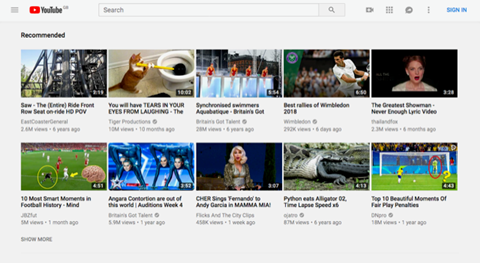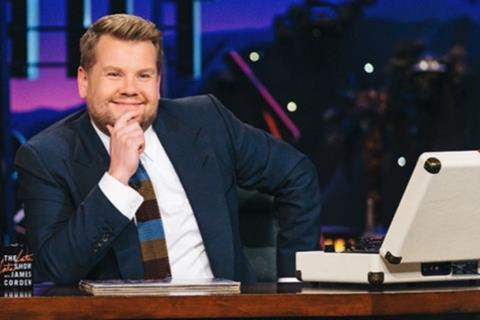YouTube has changed the future of television forever. On its 15th anniversary IBC365 examines the impact of the online video platform and looks at how it has revolutionised the motion picture.
Linear television and cable broadcasting may have dominated news and dissemination with talk shows, TV series, exercise classes and late-night content captivating audiences around the globe.
But it is YouTube that has harnessed users’ creativity, while democratising the way information and entertainment is created and consumed.

Throughout the 1980’s and 90’s public service broadcasters and pay-TV channels curated genres, expanded offerings and modernised the broadcasting medium, but that was limited to reach those with a television and/or a cable connection.
International fame or fortune were not conceivable beyond the studio walls. However, all that changed when YouTube - now arguably the world’s most popular video sharing service - posted its first video on 23 April 2005, 15 years ago today.
The first YouTube video Me at the Zoo, was uploaded by the site’s co-founder Jawed Karim under the username ‘jawed’ and was recorded by his high school friend Yakov Lapitsky who created an account on the same day. It has since had more than 90 million views at the time of publication.
In 2010, a report from the Los Angeles Times explained that as the first video on YouTube “it played a pivotal role in fundamentally altering how people consumed media and helped usher in a golden era of the 60-second video.”
Today, YouTube has evolved into a sophisticated service with a premium subscription model and live video features as well as its traditional legacy video hosting platform; the seemingly ordinary video of Karim has stood as an extraordinary moment in the history of YouTube.
YouTube laid the groundwork and contributed to the growth and popularisation of on-demand online video streaming with its service evolving over the years. It also transformed advertising models for the media and entertainment sector.
Ampere Analysis research manager Daniel Gadher says: “One key area where YouTube’s impact has been clearly seen is in the shifting dynamics of the advertising industry.
“Previously the lion share of advertising revenue was generated from broadcast TV. Over the last 15 years there has been a shift towards online advertising and as a subset of that online video advertising.
“YouTube in 2019 generated over $15bn in advertising revenue.”
YouTube’s head of EMEA business Cécile Frot-Coutaz:
The first adverts were rolled out in August 2007. By May 2010, YouTube served more than two billion views per day and in 2012 it streamed the first US Presidential debate. By March 2013 – less than eight years after launch, it was seeing one billion active monthly users.
The concept of YouTube’s user generated content took the role of authoritative, journalistic and commercialised or public service broadcasting to the citizens. As such it democratised video and created an entire new genre of content creation and consumption beyond the television.
Gadher adds: “The content on the platform has grown to include originally made content, licensed content from major studios and producers and as a digital video transaction store, highlighting its importance in the industry for consumer engagement.”
Tuning in
Me at the Zoo has become indicative of some of the most popular and viral videos to come out of the platform, with Charlie bit my finger posted on 22 May 2007, today has 873 million views to the popular Baby Panda Sneezing Video from 8 March 2014 which went viral on news programmes and classrooms, has 454 million views.
The Evolution of Dance from 6 April 2006, today has 307 million views and Susan Boyle – Britains Got Talent 2009 Episode 1 – Saturday 11th April | HD High Quality was uploaded on 11 April 2009 and has been viewed 242 million times to date.
The aptly named The Annoying Orange video boasts 219 million view and was posted 10 years ago. It also has a dedicated channel with 9.76 million subscribers and over 1,400 videos.
These viral videos which have been viewed millions of times respectively can be categorised as defining the first decade of the platform, with today’s most popular video coming from musicians including Luis Fonsi’s Despacito ft. Daddy Yankee - a hit during summer 2018 in Europe and beyond -which boasts the most YouTube views ever, with more than six billion views after it was uploaded on 13 January 2017.
YouTube has become the world’s largest video hosting website, and one of the internet’s most popular search engines, second only to its parent company, Google, which bought YouTube for $1.65 billion in 2006.
In 2007, YouTube consumed as much bandwidth as the entire internet in the year 2000, according to a report from Telegraph.
“YouTube is central to today’s video ecosystem,” Enders Analysis research analyst Jamie McGowan Stuart explains: “YouTube’s impact on the industry will grow even more as its offering on TVs develops.”

At the centre of monumental moments both good and bad, YouTube has played host to a new generation of creators and allowed broadcasters to reach viewers particularly younger demographic of audiences.
In the UK, 16-34-year olds on average watch over an hour of YouTube a day. McGowan Stuart explains: “It is also worth considering the current circumstances around Covid-19 and the ways traditional media are using techniques and styles forged on YouTube to adapt their content to a remote world.”
YouTube’s long tail of content gives consumers unprecedented choice in consumption and, despite the rise of TikTok challenging users’ time, platforms ultimately need to incentivise their creators.
McGowan Stuarts says: “As yet, none has done so at the scale that YouTube can, with its two billion users and tried and tested monetisation programme.”
Vlogging for virality
Artists ranking in the top ten include Ed Sheeran, Katy Perry, Mark Ronson, Maroon 5 and Justin Bieber who became the second musical artist to achieve one billion views on YouTube with his song Baby from 2010. This was then surpassed by his track Sorry from 2015. It was the 22nd video to reach the billion-view status on YouTube and has since reached more than three billion views.
South Korean pop musician, Psy went viral for his dancing video and song Gangnam Style which was posted seven years ago on 15 July 2012 and has 3.5 billion views and 17 million likes. It was the first YouTube video ever to be viewed more than one billion times within the first six months of its release. In May 2014 it gained two billion views and wasn’t tailed until 2015.
With a strong dominance of English-language and music videos triumphing one of the only videos that has gone viral and sets itself apart from the previous videos is Masha and The Bear - Recipe for Disaster (Episode 17), which is an animation aimed at children from Russia CGI company Animaccord Animation Studio and was uploaded to YouTube by Get Movies. It is also broadcast on Netflix and NBCUniversal and is one of the only videos with such high views, at 4.2 billion to date.
Not to be forgotten is Korean pop manufacturer Pinkfong’s Baby Shark Dance video with more than five million views since 17 July 2016. It has been made into various parodies including James Cordon’s Céline Dion Carpool Karaoke from 21 May 2019 with 25 million views.
Catalyst for change
YouTube is enormously successful with its audience engagement and has truly been a catalyst for change within the entire video ecosystem, with 70% of YouTube views coming from mobile devices – a massive shift in how we consume video.

According to figures from Statista between 2007 and 2019, there were more than 500 hours of video content uploaded to YouTube every minute which equates to approximately 30,000 hours of newly uploaded content per hour.
As consumers appetite for online video content grows, the quantity of videos on YouTube has mirrored this demand and the number of video content hours uploaded every 60 seconds grew by 40% between 2014 and 2019.
It is fair to say that YouTube has become a flashpoint in ongoing debates over issues such as online harassment, misinformation and the impact of technology on children’s content.
However, according to YouTube’s head of EMEA business Cécile Frot-Coutaz, who spoke at IBC last year, YouTube is an “adjacent” business to TV.
She said: “We are constantly looking at tools and enhancements we can provide as a platform to help the variety of storytelling, but also the quality of engagement for creators and audience.”
- Read more: Interview: Cécile Frot-Coutaz

Perhaps the most unique movement YouTube has harnessed is its ability for TV stars - notably comedians - to engineer segments of its programming to be consumable as YouTube clips. The likes of Jimmy Fallon, James Cordon and Seth Meyers are among the US-based stars joining some of the most successful vloggers including newcomers such as PewDiePie, a Swedish YouTuber with the most-subscribed users on any channel from 2013 to 2019.
According to a report from Video Consumer Insights, by 2025, half of the viewers under the age of 32 will not subscribe to a pay-TV service with six out of ten people preferring online video platforms for TV.
On mobile alone, YouTube reaches more 18 to 49-year-olds than any other broadcast or cable TV network and has launched in over 91 countries in a total of 80 different languages, which cover a total of 95% of the internet population.
To close the gap with television, YouTube has offered full-length movies, two-hour concerts and live sporting events for some years. The platform has put an emphasis on more polished videos from independent movie producers, major record labels and even Hollywood studios.
- Read more: YouTube: Can Google’s SVOD rule the OTTs?




























No comments yet